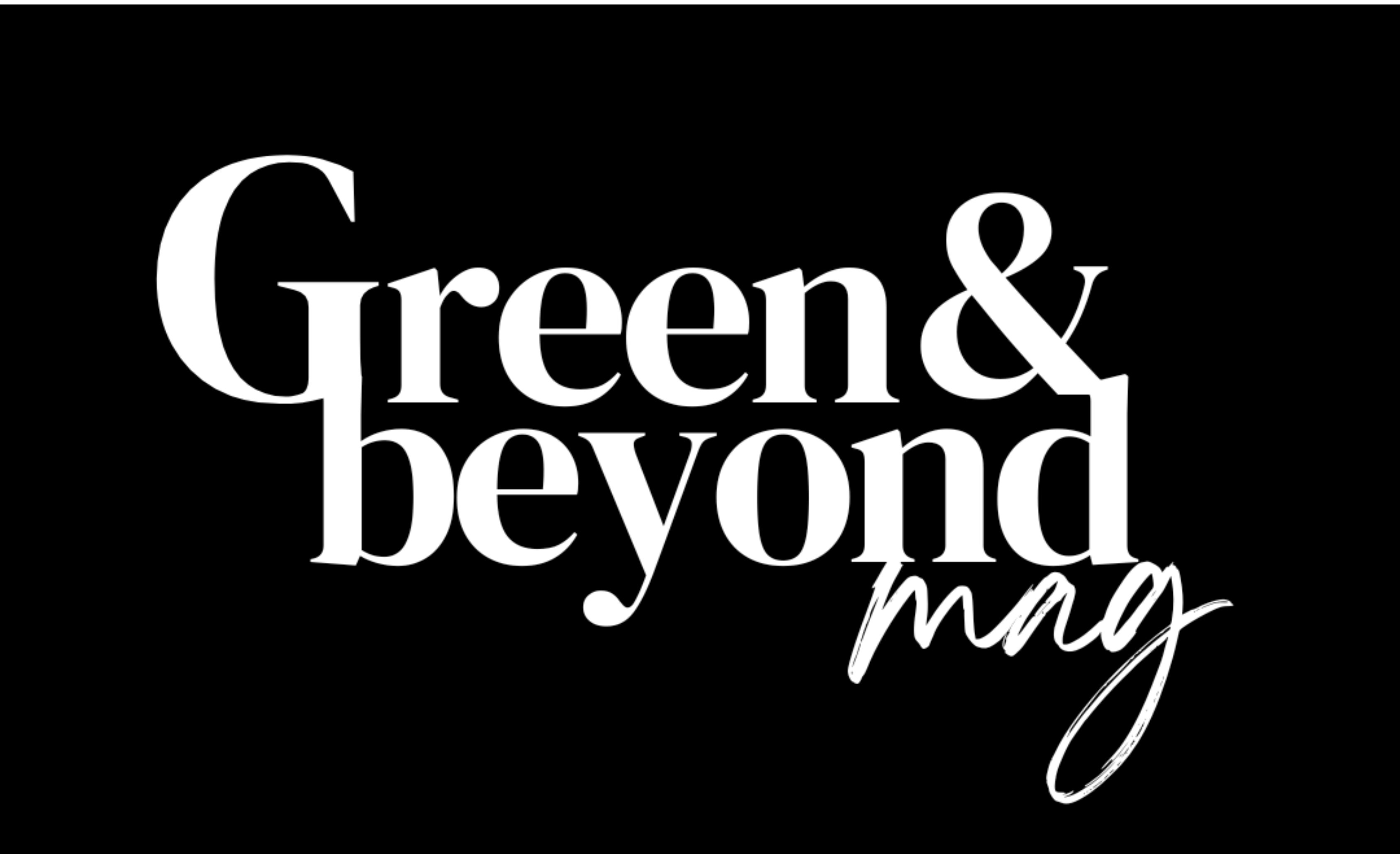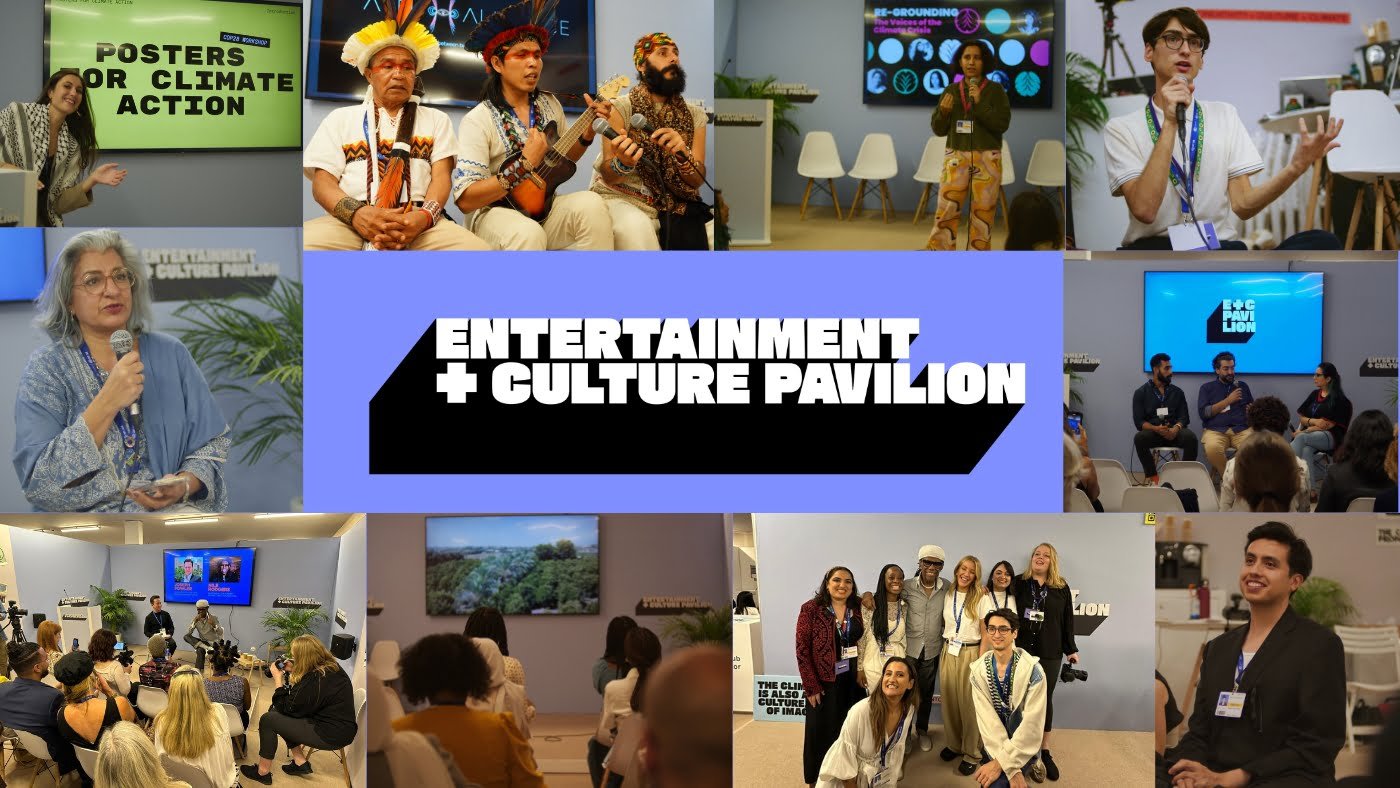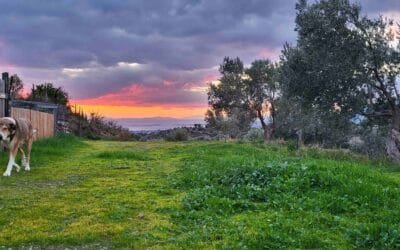Remember how Michael Jackson’s “Heal the World” filled us with hope, or how Mad Max: Fury Road‘s representation of a dystopian future got us thinking? That’s the incredible power of entertainment and culture – to move us, connect us, and motivate us to make a difference. And guess what? As media partners of the groundbreaking first-ever Entertainment + Culture Pavilion at COP28 in Dubai, we witnessed this power firsthand!
Just imagine 12 days pulsating with energy, packed with over 100 programming events representing 60 countries and reaching a combined audience of 22 million! The E+C Pavilion wasn’t just a space; it was a global movement in action, fueled by the diverse voices and shared passion of artists, activists, and policymakers from around the world; it was a stage where cultural icons and celebrities weren’t just name drops, but passionate advocates; where music wasn’t just background noise, but a call to action; where speeches weren’t just lectures, but heartfelt pleas for a better future. That’s what we witnessed the Pavilion offer – a space where emotions ran high, connections were made, and one truth resonated loud and clear: change is possible, and it starts with the fire in our hearts and the actions in our hands.
The essence of this editorial is to share the impact of the Pavilion and to explore how impactful narratives can spark conversations and inspire change. Ultimately, this is my reflection on the potential of entertainment and culture to become powerful tools for positive change, a message carried by every performance, panel, and conversation that unfolded within the Pavilion’s walls.
Assessing Success: A Multifaceted Triumph
At COP28, the E+C Pavilion was a movement in action, fueled by nine key themes that blended like musical notes to create a powerful song of change. Now, in order to actually understand the impact of the pavilion, let’s explore the nine key programming themes of the pavilion and also take a trip back in time at the Cop28 blue zone, B7, Building 90 of the Expo City in Dubai, to revisit some of the incredible events (only some, because there were like over 100 of them!).

- Creative Economy & Narrative Impact Climate Storytelling: We witnessed some incredible exhibitions showcasing diverse artwork, poetry, and stories from Southeast Asia amplifying voices and perspectives often unheard in climate discussions. Workshops like the “Climate Music Workshop: Disappearing Studio Ghibli World,” merged music education with climate awareness, empowering participants to use their creativity to address environmental challenges. Moreover, events like the Indigenous Youth Perspectives on Climate Program provided a platform for young indigenous voices, highlighting the importance of intergenerational knowledge transfer and youth leadership.
A particularly engaging installation, ‘Storytelling with Saris’ by Monica Jahan Bose, added a unique cultural perspective to the narrative. Draping colorful handwoven sarees from Bangladesh, symbolizing sustainability, this art installation was covered with collaborative climate art and climate pledges by individuals from around the world.
“Through this initiative, Monica uplifts traditional practices in rural Bangladesh, utilizing her own traditional clothing as a tool for movement building, climate action, and empowerment. During COP, Monica will lead a performance and host a workshop at the E+C Pavilion.”
– Organizers at the E+C Pavilion
We talked to Climate Psychologist and Activist, Jessica Kleczka who believes that by harnessing the power of creative collaborations, grassroots movements can propel climate messages into the mainstream, fostering a collective recognition of everyone’s role in building a sustainable future.
“Creativity has the potential to supercharge our campaigns, break echo chambers and reach audiences who care about the state of the planet but lack a powerful message they can identify with”
– Jessica Kleczka
- Intersectional Artivism: The pavilion organized film screenings highlighting experiences from communities often overlooked in climate conversations. These sparked empathy and understanding, fostering the spirit of intersectional activism. Meanwhile, discussions linking science and storytelling, like the one with Christian Clauwers on climate photography, showcased innovative approaches to raising awareness.
- Climate Communication & Cause Marketing: Powerful films like “YOUTH v GOV Film” sparked important conversations about mental health and youth advocacy. Events like the “Time for Better Earth Disco × Hope House event” combined music, dance, and community building, reminding us that climate action can be fueled by hope and collective action.
Founder of The Climate Propagandist, Julie Mallat conducted a unique workshop called “Posters for Climate Action” where she enlightened the audience on how we can craft impactful posters for climate action and what elements contribute to persuasive design, language, and storytelling. The workshop drew from the historic roots of persuasion and explored iconic propaganda posters to equip us with the tools, insights, and inspiration to encourage the cultural rebellion we so urgently need.

- Social Impact Entertainment & Health & Mindfulness: The Time for Better Earth Disco wasn’t just entertainment; it was a space for collective joy, hope, and a sense of shared purpose in tackling climate challenges. On a more introspective note, Amina Rahma’s poetry reading offered a space for emotional expression and reflection on the human cost of climate change, promoting mindfulness and personal connection to the issue.
Some of the coolest highlights of the E+C Pavilion at COP28 was meeting iconic musicians like Ellie Goulding, Nile Rodgers and AY Young, and witnessing how passionate they are to use their art and platform to contribute in our movement to shape a better world.
“Music culture and art are something that can break down all the barriers and build bridges to connect every facet of humanity on every level.” – AY Young, Founder, Artist & Performer at Battery Tour Movement
- Cultural Heritage & Audiovisual Sovereignty: We enjoyed captivating performances by Singer Yana Mann and Violinist Annabelle Ho, where artistic talent blended with climate awareness. Events like the “Trashion Kenya Expo & Open Call for Cultural Fashion Show organized by fashion activist Habiba Abdulrahman shed light on the waste challenges in Kenya using fashion and art as powerful and creative mediums while also empowering young people from different parts of the world to showcase their beautiful cultures and heritage and advocate for sustainable practices within the fashion industry. Exhibition by Bow Seat showcased student artwork centered on climate change, amplifying youth voices through creative expression. These events highlighted the power of art to connect people to environmental issues while celebrating diverse cultural heritage.
- Sectoral Innovation & Policy: Events like the “Amazon: The New Minamata?” Film screening and discussion offered insights into the environmental impact of certain industries and potential solutions, aligning with the theme of sectoral innovation.

At this point, it’s pretty clear that The E+C Pavilion’s work at COP28 was a powerful evidence to the potential of entertainment and culture to ignite positive change. But how does this approach compare to past COPs, and what does it tell us about the future of storytelling in climate action?
Evolution of Entertainment at COPs:
While previous COP conferences have dabbled in artistic expression, it often played a marginal role while talks and policy discussions dominated the scene. The E+C Pavilion marked a significant shift, placing entertainment and culture at the heart of the conversation. This wasn’t just about raising awareness; it was about building a community, fostering empathy, and inspiring action.
Significance of this Shift:
The E+C Pavilion’s success demonstrates the immense power of engaging audiences on an emotional level. Unlike policy papers or scientific reports, stories, music, and art have the unique ability to connect with hearts and minds, bypassing cognitive barriers and sparking deeper understanding. This shift in approach at COP28 paves the way for future conferences to harness the full potential of entertainment and culture in driving meaningful change.

Stories and Art: The Changemakers We Didn’t Know We Needed
I see you’re still reading this, so I’m sure by now, you and I both get why songs like John Lennon’s “Imagine” or Bob Dylan’s “Blowin’ in the Wind” echoed through history, fueling movements for peace and justice; why documentaries like “An Inconvenient Truth” or “Blackfish” ignite public outrage and policy changes around the environment and animal welfare.
These are just a few glimpses into the vast power of stories and art. They don’t just fill us with facts; they touch our hearts, spark empathy, and push us to act. Music ignites collective action, films shed light on pressing issues, literature fosters understanding, and visual arts provoke critical thinking. I find it strikingly beautiful, how art can really change the world, one story, one song, one image at a time.
Challenges still remain.
Despite the strides, the entertainment industry isn’t exactly a superhero just yet. Let’s talk challenges and opportunities:
Access to Funding: Securing dedicated funding for climate-focused projects remains a challenge. Innovative models like impact investing and crowdfunding can offer solutions.
Greenwashing: The risk of corporations using entertainment for greenwashing needs to be addressed through stricter regulations and independent fact-checking mechanisms. We need more transparency.

In a recent conversation, Founder of TUAessence, Fernanda Lopez Lima shared with us how transparency is a key theme in her vision for change in the fashion industry.
“Differences only occur when people care. And people only care when they engage, which is only possible by learning the whole truth. Without good and real storytelling it’s impossible to create mass consciousness awareness. Therefore, the best way to change the global culture of fast consumption is to make information transparency mainstream!” – Fernanda Lopez Lima
Limited Reach: While COP28 attracted a massive audience, ensuring wider accessibility along with diverse representation in storytelling efforts remains crucial. While the E+C Pavilion actively utilized multilingual content, subtitles, and partnerships with local organizations to help bridge these gaps, climate change issues still involve jargon and a narrative that limits involvement to a specific group of people.
“This narrative needs to shift, we need to make our movements as accessible as possible and we also need to change the way we are communicating about climate change, that is more understandable, that resonates more, and draws upon people’s lived realities. Art has had and can have a huge role in helping to do this.” – Ayshka Najib, Climate Activist
But wait, there’s hope too!

We interviewed Max Han and Nurfatin Hamzah, the co-founders of Youths United for Earth (YUFE), Malaysia’s leading grassroots nonprofit mobilizing youths toward environmental action through storytelling, campaigns, and advocacy. Han was also one of the highlighted talents of the E+C Pavilion. Here’s what they think,
“Culture and entertainment enable us to look at the sobering reality of climate change from different perspectives while filling us with hope to keep going – even when we feel like the world is doomed. Climate change can feel complex and overwhelming, which is why some people push these thoughts aside or even deny it. But we can’t afford to do so. Culture and entertainment can break down difficult concepts in ways people can understand, regardless of language or location.”
– Max Han and Nurfatin Hamzah, the Co-founders of Youths United for Earth (YUFE)
In terms of traditional entertainment, Farzana Faruk Jhumu, Youth Advocate for UNICEF from Bangladesh, highlighted its role in creating resilience against rapid urbanization and environmental challenges. From farmers crafting songs as a source of rural entertainment to facing the climate crisis, these cultural expressions help communities cope with changes, resist urbanization, and inspire grassroots movements.
“This connection to nature, expressed through cultural activities, becomes a source of resilience, inspiring grassroots movements that emphasize the importance of culture and entertainment in shaping and sustaining our communities”
– Farzana Faruk Jhumu
So, the opportunities for overcoming those challenges and harnessing the industry’s influence are vast as well. Let’s take a look.
Collaboration: Cross-sector partnerships between artists, activists, businesses, and policymakers can leverage diverse expertise and resources for impactful storytelling. Did you notice how the E+C Pavilion championed that at COP28?

In line with the importance of collaboration in the climate and entertainment arena, Mitzi Jonelle Tan, Youth Advocate for Climate Action Philippines reflected on the intrinsic connection between entertainment + culture collaborations and the ability to construct a vision of a better world. She points out the power of culture to unite diverse communities against profit-oriented global systems. As she puts it, “Cultural and entertainment collaborations are so crucial because they can reach new audiences and bring more people into the climate movement.”
According to her, these collaborations are like VIP passes to reaching fresh audiences and getting more people on board in the climate movement. Not only that, but she sees them as essential in constructing the better world that’s living rent-free in our minds and hearts.
“Once we have an idea in the grasp of the joy and love in the safety, and the softness that we could be having in a better and cleaner future, it’s a lot easier for us to keep fighting no matter what, and culture and entertainment has the amazing power to build all this in our minds & in our hearts.”
– Mitzi Jonelle Tan
On the other hand, Winnie Cheche, the Founder of The Eco Advocate, envisions collaborations as a tag-team match, where culture and activism amplify each other’s voices.
“The goal is also to connect with people’s hearts and minds, and to portray climate action as both relatable and cool”
– Winnie Cheche
Technology: Utilizing immersive technologies like virtual reality and augmented reality can create really powerful, interactive experiences that raise awareness and drive action.
Data-driven strategies: Tracking the impact of campaigns and gauging audience engagement can really help us maximize impact. Data helps us understand what works and what doesn’t, making future efforts even more effective.
By addressing these challenges and embracing innovative solutions, the entertainment and culture industry can unlock its immense potential to not only raise awareness about climate change but also inspire collective action and build a more sustainable future.
My take on the Entertainment + Culture Pavilion at COP
To be honest, from the point of view of a climate journalist who is always exposed to the doom and gloom of the climate crisis, it gets pretty overwhelming. But seeing it through the lens of art, music, and personal narratives really hit me differently. Instead of climate anxiety it gave me inspiration to act and play my part. Entertainment and culture, to me, have stopped being just distractions; they have become powerful tools for understanding, connection, and most importantly, action.

By the time COP28 ended, I didn’t just have new information; I had a renewed sense of purpose. It wasn’t about waiting for someone else to save the day; it was about finding my own voice, my own story, and using it to contribute to the movement. Whether it’s sharing sustainable practices, supporting artists who raise awareness, or simply having honest conversations, there’s a role for everyone in this fight.
So, what’s our role in this story?
Are we content to be passive viewers, scrolling mindlessly through climate documentaries or tuning out powerful songs about environmental injustice? Or will we step onto the stage, utilizing the power of our choices and voices to rewrite the narrative? Such a revolution can only be possible when we all feel like playing our own roles effectively to make that happen. For that to happen, understanding the climate crisis from an empathetic point of view, not just from numbers and graphs and data, is needed.

“Getting this conversation started from a more human perspective is extremely important because facts have come out, scientists have come out, but it’s just not sticking. An important side to this is the human side, and I think that’s something that we can all connect on.”
– Maria Poonlertlarp, Thai-Swedish model, actress and singer
Here’s how we can play a major role in this (very real) apocalyptic movie:
Let’s Demand Change: Don’t be a silent supporter. Speak up! Contact your favorite streaming services, studios, and production companies. Let them know you demand climate-conscious content and sustainable practices throughout the industry. Share petitions, join advocacy groups, and raise awareness about greenwashing tactics. Show them that entertainment with a conscience is what the audience truly craves.
Amplify Diverse Voices: Seek out and share stories that go beyond the headlines. Support filmmakers, musicians, and artists from underrepresented communities who are using their talents to showcase the human stories behind climate change. Celebrate indigenous knowledge, highlight innovative solutions from developing nations, and give a platform to those often unheard in the mainstream narrative. Together, let’s create a richer, more diverse accumulation of voices fighting for our planet.

Start Conversations: Climate change isn’t just a documentary topic or a social media hashtag. Make it a dinner table conversation, a watercooler chat, a casual chat with your neighbor. Share your concerns, listen to different perspectives, and encourage open dialogue. Remember, even small conversations can spark curiosity, plant seeds of change, and inspire collective action.
Remember, every action, every story shared, is a ripple in the pond, creating a wave of change. Let’s rewrite the narrative, turning entertainment from a distraction into a powerful tool for building a more sustainable future. But the most important question remains: what story will YOU tell?
Maesha is a writer, designer and a social worker. She found her passion in writing for positive impact, specifically for the planet after having been actively involved in the development sector for over 6 years. She is an official member of Creatives For Climate and a Global Ambassador at Slow Fashion Movement.








